Pineapple is one of India’s most popular organic fruits. It is found in many states in India, including Kerala, Bihar, West Bengal, Karnataka, Goa, and Maharashtra. In addition, the yearly pineapple production is projected to be 14.6 million tons. Also, with a yearly result of 1.2 million tons, India is the world’s fifth-biggest producer of Pineapple.
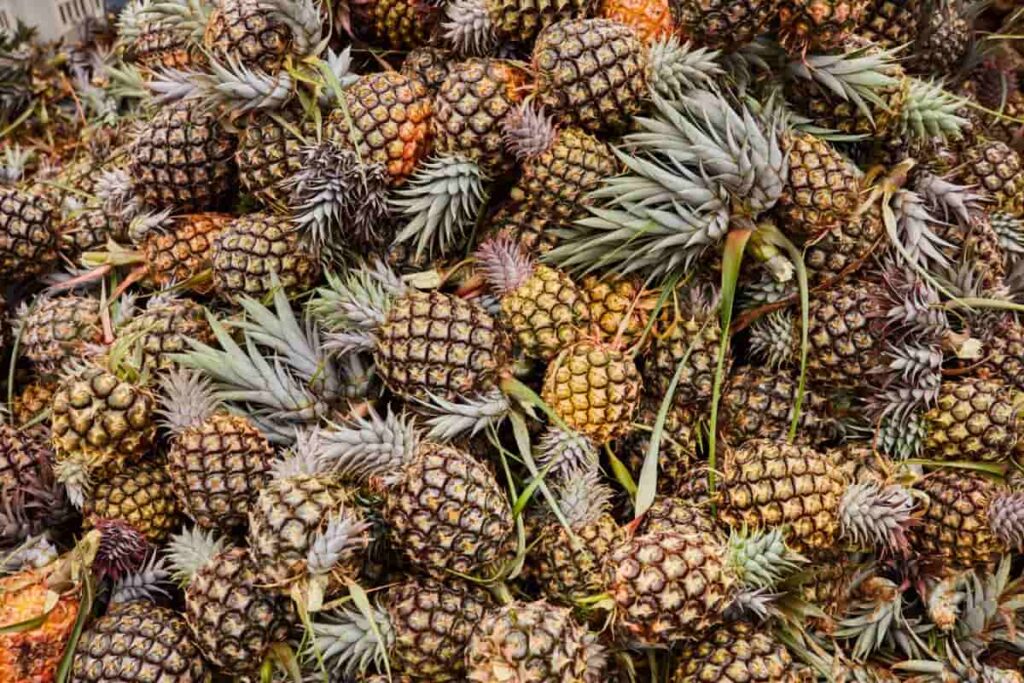
India shares 8.2% of the world’s absolute pineapple production. Colombia, Thailand, the Philippines, Nigeria, Brazil, Mexico, the United States, and Indonesia are among the top pineapple producers. In Bengal, it is grown abundantly in Darjeeling, Jalpaiguri, West Dinajpur, and parts of South 24 Parganas.
Growing Pineapple organically in West Bengal
How does the West Bengal government support organic farming
To frame an organic farming policy, the Bengal agriculture department, food processing industries, and horticulture department have started organic farming activities across the state. The increasing demand for organic vegetables, especially among urban residents, has convinced the state government to formulate an organic farming policy.
The food processing industries and horticulture department has asked the rural agricultural farms to begin organic farming and assured them of technical assistance and help in promotion and marketing. The department will supply greenhouses and pack houses along with organic fertilizers. It will also provide cars to ferry those farm products to the markets. The department is also taking up organic farming at its farms.
On the other hand, the agriculture department has set a target to prepare 32 organic villages across Bengal — especially in North and South 24 Parganas, Howrah, and Hooghly districts. It has set up 120 clusters, of 50 acres each, where organic farming is taking place. Around 194 farmhouses under the department are also farming organic vegetables separately. This apart, the department under Swanirbhar Krishi Prakalpa is collaborating with private agencies on organic farming.
In case you missed it: 20 Key Rules for Setting Up a Budget Hydroponic Garden at Home
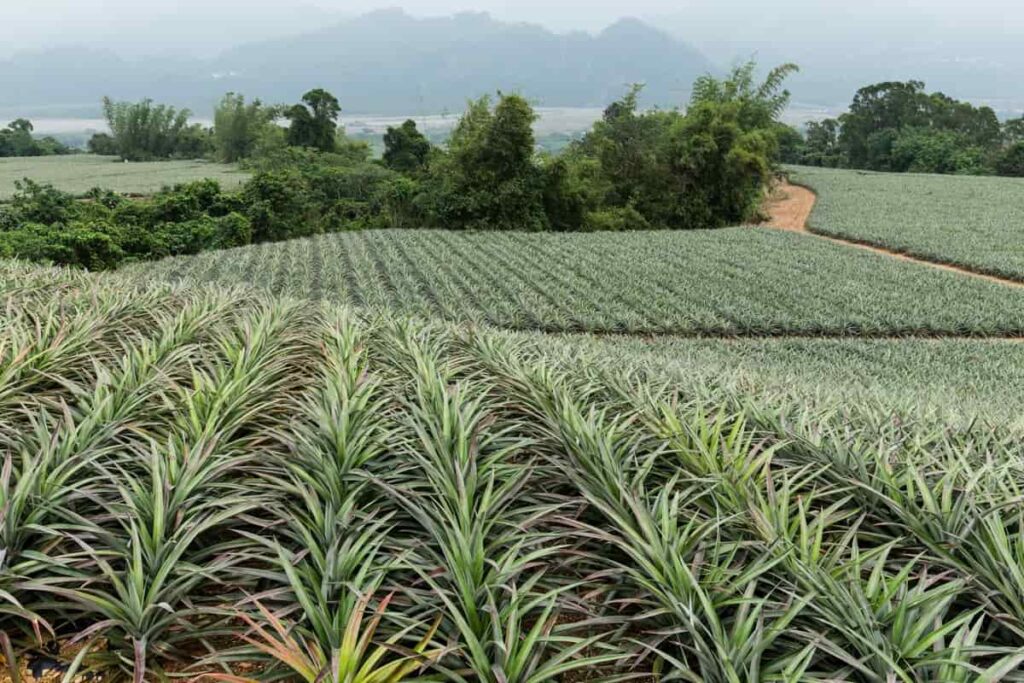
Pineapple varieties
- Gaint kew or kew:- It is one of the most important cultivars of Pineapple. It is ideal for the canning industry. The flesh of the fruit is yellow, fibreless, and juicy. The fruit is cylindrical in shape, with an average weight of 1.9 kg. It is a late-maturing variety.
- Queen:- It is the second most crucial cultivar which is grown in our country. It is an early maturing variety used as a table variety. It is mostly grown in the Bengal region. The fruits are small and cylindrical, with an average weight of 1.2 kg. The fruit color is golden yellow, while the flesh is deep golden yellow
- Mauritius: The Pineapple variety Mauritius is also known as European Pine. Mauritius is exclusively grown for table purposes. The leaves are dark green with a broad red central stripe and red spines on the margins. The Crown is also spiny. The fruit is medium, 1.36-2.25 kg, and yellow externally; it has a thin core and very sweet golden yellow flesh and juice.
Soil for Pineapple cultivation
Pineapples grow well in any soil, but sandy loam is ideal. The soil must be well-drained for pineapple farming. A good drainage capacity is necessary to grow even in clayey, heavy soil. To grow pineapples, it is not recommended to cultivate soil that logs water. In addition to alluvial and laterite soils, pineapple plantations can also be planted in alluvial soil. An acidic soil with a pH between 5.5 and 6.0 is ideal for pineapples.
Climate for Pineapple plantation
Pineapple plantations thrive in humid climates with ample rainfall. Coastal regions have this type of climate. Ideally, the temperature should range from 22°C to 32°C. Leaves grow best at 32°C, while roots grow best at 29°C. Unless the temperature is above 36°C and below 20°C, pineapple crops will not grow. Day and night temperatures should differ by 4°C. It is not desirable for pineapples to have a high nighttime temperature. It grows best at 100-150 cm of rainfall, even though ample rainfall is well-suited for pineapples.
In case you missed it: How to Grow Hydroponic Vegetables Indoors: Key Rules, Methods, and Tip
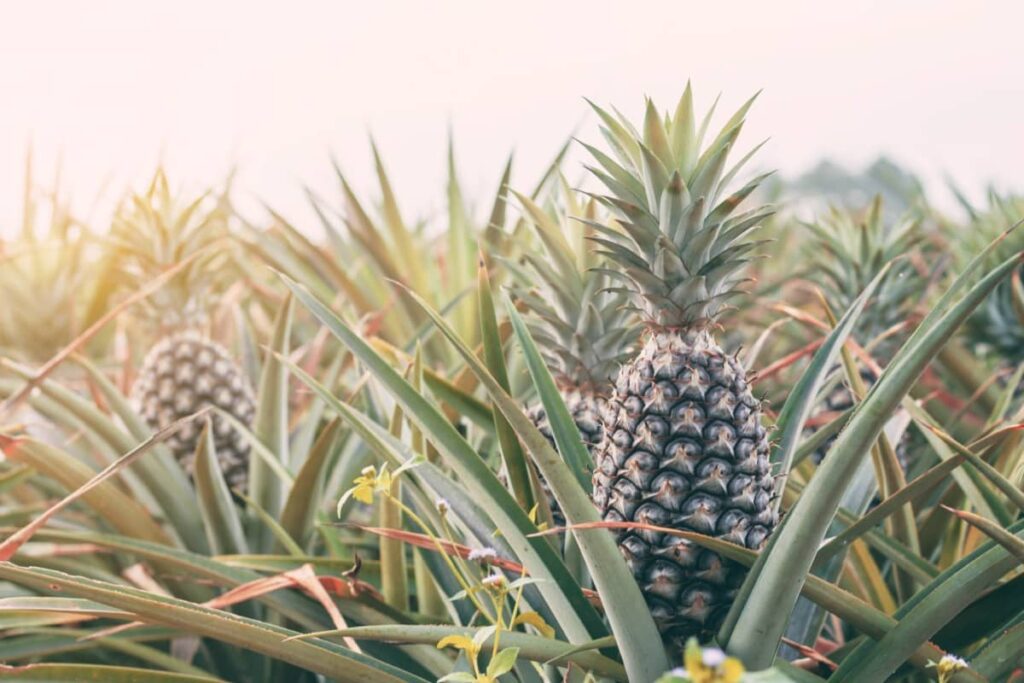
Season of Pineapple farming
In ideal conditions, pineapples should be planted 12-15 months before flowering. Between December and March, the flowering season occurs. Regions differ in this regard. As a general rule, planting time depends on the onset of the monsoon, its intensity, precipitation, etc. In Karnataka and Kerala, it is planted from April to June, while in Assam, it is planted from August to October. A heavy rainy period is not a good time to cultivate pineapples. In different states across India, the ideal time for cultivation is as follows:
| Name of the State | Time of Cultivation |
| Assam and other North Eastern States | August to October |
| Kerala and Karnataka | April to June |
| Northern parts of West Bengal | October to November |
| Other parts of West Bengal | June to July |
Land preparation for Pineapple cultivation
Trenches are used to cultivate pineapples. The first step is to plow the land well and make it level. Afterward, soil clods, rocks, crop debris, and stones must be ridden. A leveling operation is performed after the land has been plowed and dug. A trench is dug after this. Each trench may have 15-30cm of depth and 90cm of width. It is generally best to avoid harvesting during the rainy season between August and October or April and May.
The spacing requirement in Pineapple crop
Cultivating the crop at a high density is recommended for commercial viability. A plant density of 25,500 plants per acre (22.5 cm x 60 cm x 75 cm.) is ideal for subtropical and mildly humid conditions, while 21,500 plants per acre are ideal for hot and humid conditions. Plants are spaced 25 cm apart within a row, 60 cm between rows, and 90 cm between trenches (25 x 60 x 90 cm). A somewhat lower density of 12,500 plants/acre is recommended in northeastern states’ rainfed, highly fertile, and hilly areas.
Selection of suckers for Pineapple cultivation
Suckers are selected from disease and pest-free healthy plants. Suckers are to be graded into those having less than 500 grams, 500-750 grams, and more than 750 grams in weight to avoid competition between plants of different sizes. Suckers weighing 400-500 grams or slips weighing 350-450 grams are ideal for planting. The graded suckers are planted in different blocks or plots for uniformity in growth and flowering. Bigger suckers give early yield.
Before planting, curing slips and suckers for 8-10 days in the shade is necessary as fresh suckers planted in moist soil begin to decay. Before planting, some of the lower leaves are removed from the sucker to facilitate the formation and entry of roots into the soil. After removing scaly leaves, planting material should be treated with a Bordeaux mixture solution to protect against mealy bugs and heart rot.
In case you missed it: How to Maintain the pH Levels of Hydroponic Systems: Increase, Decrease, and Stabilize
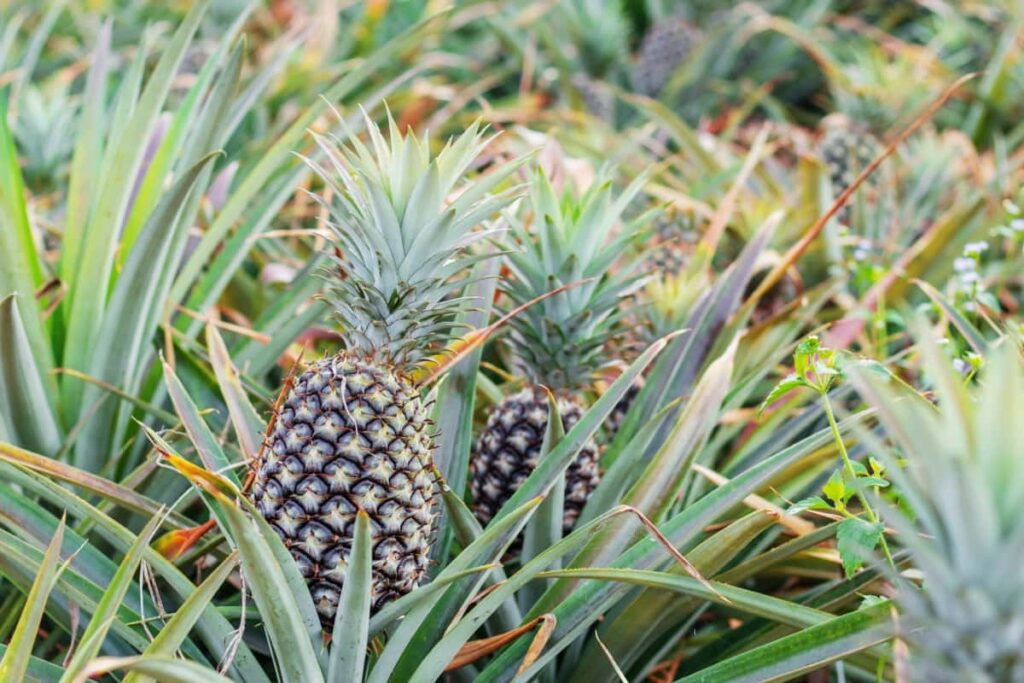
Pineapple planting
Pineapples are propagated from a crown, sucker, and slip instead of other crops. As a result, crowns, slips, and suckers are used in pineapple cultivation. Suckers and slips bear flowers 12 months after planting, while crowns bear flowers 19-20 months after planting. Planting materials used for cultivation should therefore be at least 5-6 months old. Slips and suckers are generally used for commercial purposes, as crowns take longer to flower. Material sizes must be uniform. In trenches that have already been dug and prepared, suckers and slips are planted.
Water requirements for Pineapple farming
In coastal areas and places with abundant rainfall, pineapples are commonly grown. As a result, irrigation is not necessary. In commercial cultivation, supplementary irrigation helps produce good-sized fruits. Additionally, irrigation facilitates off-season planting. In addition, it ensures pineapple production throughout the year. Export-quality pineapples are produced using this method. Irrigation is necessary once every two weeks if grown in areas with scant rainfall and hot weather.
Manure application in Pineapple crop
Pineapples have a high nitrogen and potassium requirement and are shallow feeders. Considering that these nutrients are prone to heavy losses in the soil, the time of application and fertilizer type determine their efficiency. Pineapples’ Phosphorus (P) requirement is relatively low compared to other fruit crops. The amount of fertilizer needed depends on the soil’s nutrient status. Therefore, heavy manure application is required for pineapple plants. During the first six months, 20 to 30 tons of cow dung manure should be applied.
Crop maintenance operations in Pineapple plantation
A variety of intercultural operations are used in pineapple farming, including earthing, weeding, mulching, removing slips, suckers, crowns, and ratoon crops. Due to pineapples’ shallow roots and loose soil, this is especially true. Here are some pineapple farming techniques.
Earthing in Pineapple cultivation
The roots of pineapples are shallow. This makes them prone to lodging. Plants that lodge during fruit development will produce uneven fruit and lopsided growth. A good anchorage is achieved by earthing plants. Earthing involves pushing soil down from ridges into trenches.
Weed control in Pineapple cultivation
Any cultivation relies heavily on weeding from an economic perspective. Two types of weeds most commonly found in Pineapple are nutgrass and hariyali. Using chemical weeding is more efficient and less time-consuming than hand weeding. The combination of diuron and bromacil is usually recommended as a pre-emergency spray. 0.6 kg of diuron and 0.8 kg of bromacil are used in the pre-emergency spray. Five months after the first application, it was repeated with half the concentration.
Mulching in Pineapple cultivation
Pineapples grown as rain-fed crops require mulching. Mulching is primarily used to conserve moisture and control weeds. Mulching is the easiest and least labor-intensive with a black polythene film. An organic way of mulching pineapple plants is to use a mulch of leaves and straws spread between them.
Removing crowns, slips, and suckers in Pine apple cultivation
Inflorescence and fruit development produce suckers and slips, respectively. Most suckers and slips are removed, with only a few retained. A higher number of slips delays fruit maturity, so they are removed as soon as they reach the size required for planting. In contrast, fruit weight increases as suckers increase. Desuckering can therefore be delayed. As a result, the slips are removed as soon as they appear if the farmer intends to harvest early.
In case you missed it: Farming Business Plan PDF: for Poultry, Livestock, Agriculture, Horticulture, Greenhouse, and Hydroponic
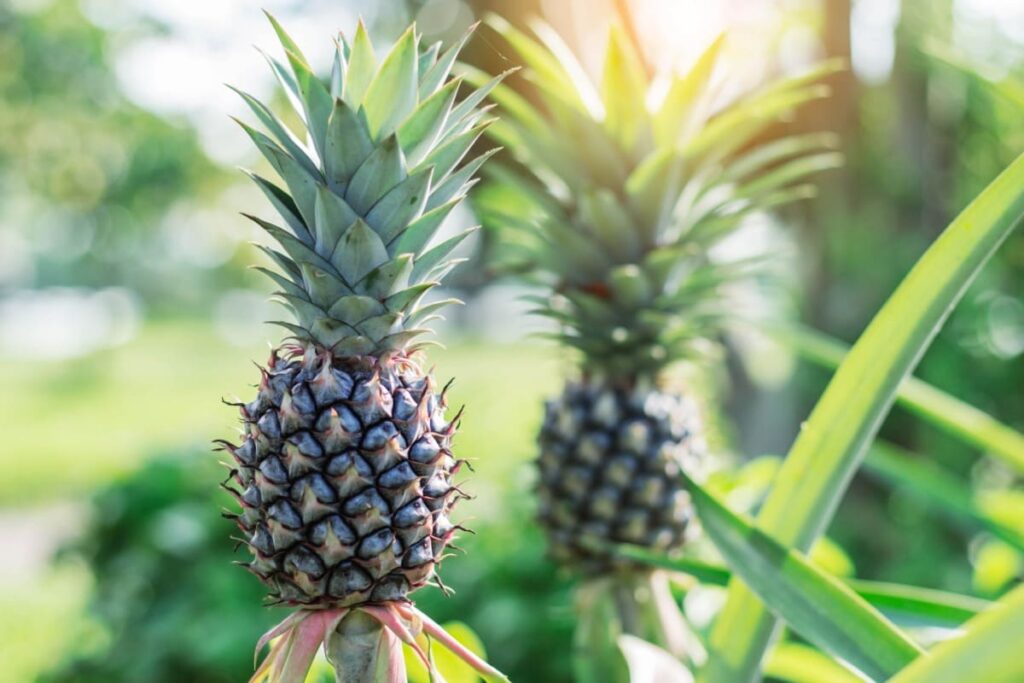
Major pests and their organic control
Mealybug
Damage symptoms
- The leaves appear pale green to yellow, streaked with brown tips.
- It is characterized by the wilting of leaves starting at the tips of the leaves.
- In areas of wilting, there is a reddish-yellow color.
Control
- Avoid using 5-6 years old suckers for planting
- Mealybug spread can be minimized by destroying ant colonies.
- The mealybug-infested fields must be prepared by removing all the plant residues and incinerating them.
Pineapple scale
Damage symptoms
- Rust-colored spots are a symptom of an attack.
- Secretions serve as a shield for the insect.
- This insect’s scale or protective armor is partly waxy secretion and partly molted skin.
Control
- When starting new plants, use clean soil media and inspect them frequently to prevent scale infestations.
- Natural enemies like Tiny wasps may biologically control this pest by parasitizing the scales.
Pineapple fruit borer
Damage symptoms
- The fruit borer larvae open galleries in the pulp, producing an oozing called “gummosis” on the outer side of the fruit.
- Insect damage leads to product rejection at the packing plant
Control
- Select a variety tolerant to this pest and plant them with proper spacing.
- Predators: Mirid bug, reduviid bug, big-eyed bugs, rove beetle, dragonfly, damselfly, spider, robber fly, praying mantis, red ants, lacewings, etc.
Diseases in Pineapple farming and their organic control
Phytophthora heart (top) rot
Damage symptoms
- The color of the heart leaves changes to yellow or light coppery brown.
- Later, the heart leaves wilt (causing the leaf edges to roll under), turn brown, and eventually die.
Control
- Avoid excessively deep planting
- Prevent soil enter into the heart during planting
- Maintain proper drainage to minimize the risk of Phytophthora infection.
- Planting on raised beds of at least 20 cm in height.
Green fruit rot
Damage symptoms
- There are no external symptoms of water-soaked rot that develops internally behind affected fruit leaves.
- As the disease progresses, green fruit develops a brown margin and a general water-soaked rot.
Control
- In dry weather and with good air circulation, seed material should be stored on main plants.
- Black rot can be reduced by avoiding bruising and wounding of fruit during harvest.
In case you missed it: How to Plant and Care for Hydrangeas: Steps to Grow Hydrangeas for Beginners
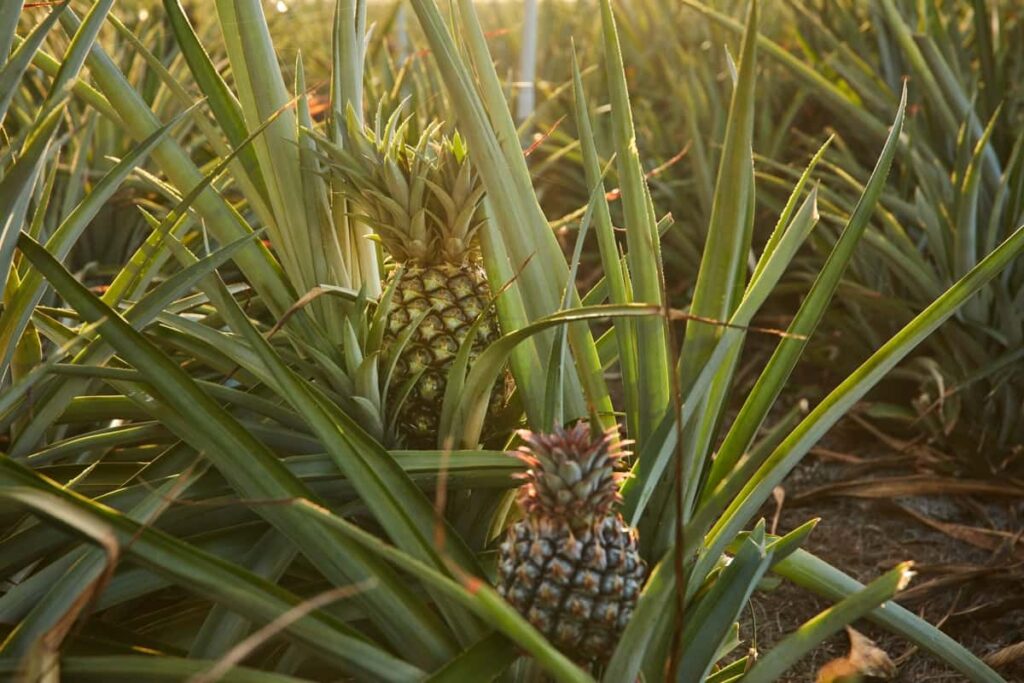
White leaf spot
Damage symptoms
- When another leaf has rubbed the leaf margin during strong winds, a small, brown spot appears on the leaf.
- Wet weather causes these spots to lengthen rapidly. Spots can grow up to 20 cm in length and spread to the leaf tip during prolonged wet periods.
Control
- To prevent the pathogen’s spread, avoid wounds to tissue and remove infected pineapple plants.
- Avoid planting during wet weather and improve soil drainage.
Harvesting and yield in Pineapple crop
It takes 12-15 months for pineapple plants to flower after planting. Depending on the variety, planting time, type and size of plant material, and prevailing temperature during fruit development, the fruits take 15-18 months to mature. During natural conditions, pineapples are harvested between May and August. Five months after flowering, the fruit usually ripens. Due to irregular flowering, harvesting occurs over a long period.
When the base of developing fruits changes slightly, the fruits are harvested for canning purposes. It is necessary to retain fruits used for table purposes until they have developed golden yellow color. Depending on soil conditions, the plant crop can be retained as a ratoon crop for three to four years after harvest. In high-density plantings, ratooning reveals that the average fruit weight in the first and second ratoons is 88% and 79%, respectively. Generally, yields range from 20-36 tonnes per acre, depending on spacing and cultural practices.
Conclusion
The Pineapple ranks second to the mango as one of the most popular fruits. On the outside, pineapples are thorny and spiny. However, on the inside, pineapples are sweet and delicious. Knowing how to grow Pineapple can be a profitable business, especially since it does not suffer from too many diseases. Plantations of pineapples can therefore be an excellent source of income if they are correctly maintained.
- Irrigation and Water Management in Pineapple Farming
- Blossom to Harvest: Mastering Flowering and Pollination in Papaya Farming
- Pig Fattening Essentials: From Selection to Sale for Beginners
- Raising Wagyu Cattle: A Complete Guide for Premium Beef Production
- Soil Types and Their Water Holding Capacity
- Optimizing Irrigation Schedules for Coconut Groves for Enhanced Yield
- Espresso Your Garden: Coffee Grounds for Healthier Acid-Loving Plants
- The Best Soil Mix for Snake Plants: How to Mix Your Own Snake Plant Soil
- Green Thumb Success: Expert Tips for Cultivating Greenhouse Beans All Year Round
- Bloom All Year Round: The Ultimate Guide to Indoor Hyacinth Care
- Eco-Friendly Gardening: How to Make Liquid Fertilizer from Kitchen Waste
- Ultimate Guide to Grow Anise in Pots: Explore Seed Propagation to Harvesting
- Guide to Raising Chester White Pigs: Discover Breed Facts to Growth Management
- Mastering the Elegance: The Ultimate Guide to Weeping Cherry Tree Care, Planting, and Maintenance
- Ultimate Guide to Planting Garlic in Grow Bags: Growing Strategies for Beginners
- How to Fix Spider Plant Leaf-Related Problems: Natural and Organic Remedies
- 10 Reasons Why Your Tulsi Plant is Shedding Leaves: Home Remedies and Solutions
- Optimizing Growth and Yield: The Advantages of Palm Bunch Ash Fertilizer
- Utilizing Neem Oil Extract as a Natural Pesticide for Hydrangea
- From Soil to Harvest: Various Ways in Which Farmers Can Use AI Tools
- Steps to Encourage and Induce Citrus Flowers: A Comprehensive Guide
- How to Fix Snake Plant Leaf-Related Issues: Natural and Organic Remedies
- Transform Your Garden into a Fragrant Oasis with Raat Ki Rani (Night Blooming Jasmine)
- Discover the Ideal Chicken Breeds for Philippine Farms
- How to Create a Poultry Egg Farm Business Plan for Profits
- Grow Lemon Cucumbers Like a Pro: Insider Techniques for Bountiful Yields
- Ultimate Guide to Caring for Your Pink Princess Philodendron: Tips for Thriving Variegation
- Areca Nut Profit Per Acre: Calculating Yield and Cost of Cultivation
- How Kaveri Chicken is Becoming a More Profitable Breed in Indian Backyards
- Transform Your Barn: 9 Steps to Convert a Horse Stall into a Chicken Coop
- Exploring Suffolk Sheep Disadvantages with Limitations and Challenges
- Guide to Solving Potted Lemon Tree Problems: How to Revive Lemon Tree in Containers
- Steps to Encourage Female Pumpkin Flowers: Best Strategies for More Flowers and High Yields
- Ultimate Guide to Yellow Raspberries: Exploring from Planting to Care
- Ultimate Guide to Planting Ginger in Grow Bags: Growing Strategies for Beginners
- Ultimate Guide to Growing Red Creeping Thyme: Propagation, Planting, Pruning, and Care
=
